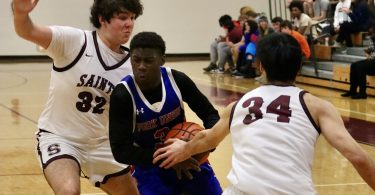Every day is a different struggle for Holland Edmonds. Diagnosed with type 1 diabetes when she was two years old, Edmonds spends a significant portion of her time and energy trying to walk the tightrope of a healthy blood sugar level. It never stops, and depending on the day, managing the blood-sugar line can be more difficult than others.
There are a lot of tough days for Edmonds during the summer. As a member of Farmington’s Jefferson Swim League, the St. Anne’s-Belfield middle-schooler spents a lot her energy burning through sugar in the pool as she swims the 50 meter butterfly and numerous relay races for the Frogs. When she does so, she enters the meet at well above, sometimes even double her usual blood-sugar level to avoid crashing into hypoglycemia, which if unmonitored, can prove fatal.
“It’s a lot better to be a little bit higher after a meet than lower,” Edmonds said. “But everyday, every meet is different.”
From someone looking on the outside in, it would appear that athletics and type 1 diabetes are like oil and water. But Edmonds isn’t the first to battle with it, and that’s been a big help.
Gary Hall Jr. was just a few months away from competing in the Sydney Olympics in 2000 when he was diagnosed with type 1 diabetes. There was much debate as to whether or not Hall would be able to maintain his Olympic level form while having to constantly worry about and tweak his blood-sugar levels. But Hall left no doubt about it. Before being diagnosed with diabetes, Hall had four medals. Afterwords, he accumulated six more, including gold medals in both the 2000 and 2004 Olympics in one of swimming’s most prestigious races, the 50 freestyle.
When Edmonds was five years old she got an opportunity to meet Hall at a congressional hearing about diabetes and athletics. It’s something that she remembers well.
“That was so cool,” Edmonds said of her first encounter. “I got to meet an Olympic swimmer but he’s also someone that goes through the same things I do. He’s one of my favorite (athletes) and I want to be just like him. It was cool to learn about how he (deals with diabetes) so that I could too.”
It wasn’t the last time she crossed paths with the Olympic champ. Edmonds participated in a diabetes research fundraiser that Hall was emceeing for. He wound up interviewing Edmonds on stage at the event.
“It was really amazing to see how empathetic he was with a seven-year old kid,” said Edmonds mother, Cindy. “He’s so good with them and you can really see that this has become his cause and it’s very inspirational for us.”
While she or her parents initially injected insulin via syringe early on to maintain her blood-sugar levels, Edmonds has since moved to an insulin pump. With a pump, a hose is inserted into the stomach where insulin is pumped in directly whenever a small computer deems it necessary. While some diabetics prefer not carry around the pump, many others enjoy the freedom of not having to constantly keep watch over blood sugar levels and insulin injections.
“It’s just a lot easier for me,” Edmonds said of using a pump. “I have more control. I can keep certain things from happening if I don’t want them to. It’s also easier to give just a little of insulin with a pump than with a needle. And if I don’t want the insulin I can stop it.”
Of course, the pump and hose have to be removed before Edmonds jumps into the pool. When it comes to swimming there are a number of variables a diabetic must battle with. First Edmonds makes sure she has enough energy to get through the meet, but with both insulin and her body burning through her energy, nights after swim meets are every bit as important to keep an eye open.
“Swimming is tough,” Cindy said. “We’re never able to get it perfect. It’s different every time and we have to tweak things here and there.”
But week after week, Edmonds is in the pool doing what she wants to do, no matter how hard it can be before, during or after. While she may draw inspiration from Hall, coaches and swimmers in area can find the same in her.


